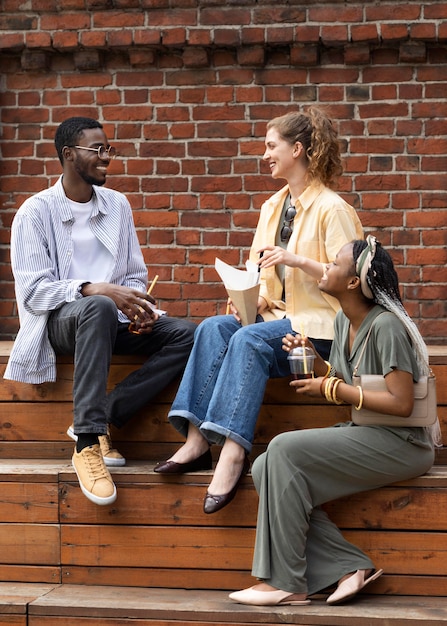👩🍼ASL Level 5, Activity 09-Family Dynamics Pt.2 (Online)
Description:
Students will present stories about family members and relationships with the group. They will then explore what it’s like to be a Deaf child of hearing parents or vice versa.
Products: Familial relationships, CODA
Standards
NCSSFL-ACTFL World-Readiness Standards:
- Standard 4.2 Students demonstrate understanding of the nature of culture through comparisons of American Deaf culture and their own.
- Standard 2.2 Students demonstrate an understanding of the relationship between the products and perspectives of American Deaf culture.
Idaho Content Standards for World Languages:
- Objective: COMM 3.2 Adapt presentation to various audiences of listeners, readers, or viewers.
- Objective: CONN 2.3 Compare and contrast cultural similarities and differences in authentic materials.
Can-Do Statements
NCSSFL-ACTFL Can-Do Statements:
- I can practice explaining relationships.
- I can index while signing a story with many people.
- I can discuss family dynamics other than my own.
Materials Needed
Warm-up
Materials Needed for Warm-up
- Ask students to type their name and ID # for attendance
- “YOU LIST 2- NAME, ID NUMBER TYPE”
- Start with 5-minute conversations in breakout rooms
- “START BREAKOUT ROOMS TIME 5 MINUTE CONVERSATION DISCUSS WHATEVER”
- Review Vocabulary
- PARENTS
- Dominant hand shaped 5 taps chin, then forehead.
- SIBLINGS
- Left and right hand shapes 21. Nondominant hand in front of chest. Dominant hand moves from forehead to top of nondominant hand, then to chin and back to top of nondominant hand.
- GRANDPARENTS
- Left and right hand shapes 5. One hand’s thumb will be placed on forehead, and the other on the chin. Move hands forward two spaces.
- RELATIONSHIP
- Left and right hand shapes F and interlocked between thumbs and index fingers. Place in front of body and move back and forth two times.
- PARENTS
- Watch the video on Children of Deaf Adults
- “NOW VIDEO WATCH TOPIC WHAT? CHILDREN GROW UP THEIR MOM DAD DEAF”
- Discussion on video
- What did you think about the video?
- “VIDEO YOU THINK WHAT?”
- What challenges might come with being CODA?
- “CODA CHALLENGES HAVE WHAT?”
- Have you ever been asked if you are CODA when you told someone you know ASL?
- “PAST YOU KNOW SIGN LANGUAGE TELL PERSON THEY ASK YOU CODA?”
- What did you think about the video?
- Have students take turns and pick one discussion question to answer
- Do you have a brother or sister?
- “BROTHER / SISTER ME (DON’T HAVE / HAVE). SIBLINGS ____, (NAME AND AGE)”
- What are your parents’ names
- “MY PARENTS NAMES _______ AND _______”
- Do you have a brother or sister?
Main Activity
Materials Needed for Main Activity
- Send students each a different“family tree” (a list of characters) and a story that utilizes those characters.
- “ALL FAMILY STORY DIFFERENT HAVE”
- Give students a couple of minutes to practice those stories.
- “TIME 2-3 MINUTES STORY PRACTICE”
- After, students will present their stories to the lab class.
- “NOW TAKE TURNS STORY GROUP SHARE”
- See if students understand the story and the characters’ relationships. Ask checkpoint questions to ensure they understand (e.g., who was the brother? What did he do on Tuesday? etc.)
Wrap-up
- Explore how you think you would feel if you were:
- A hearing kid in a Deaf family
- “YOU IMAGINE YOU HEARING KID DEAF FAMILY GROW UP”
- A Deaf kid in a hearing family
- “YOU IMAGINE YOU DEAF KID HEARING FAMILY GROW UP”
- A Deaf kid in a Deaf family
- “YOU IMAGINE YOU DEAF KID DEAF FAMILY GROW UP”
- A hearing kid in a Deaf family
- What are the similarities and differences?
- “SAME DIFFERENT WHAT?”
Deaf Culture
Children of Deaf Adults (CODA) that learn sign are recognized as members of the Deaf community even though they are hearing. Family ideals on oral vs sign language communication play a huge role in what their children will learn and what kind of school they attend. Unfortunately, children don’t have much say when it comes to early education but Deaf kids that communicate orally can make the decision for themselves to learn sign language later in life.
End of Lab:
- Sign or show Can-Do statements once more and have students evaluate their confidence
- (Use thumbs up/ thumbs down or have them rate 1-5 on how they feel after the activity)
- Encourage students to be honest in their self-evaluation
- Pay attention and try to use feedback for future labs!
Can-Do Statements
NCSSFL-ACTFL Can-Do Statements:
- I can practice explaining relationships.
- I can index while signing a story with many people.
- I can discuss family dynamics other than my own.


